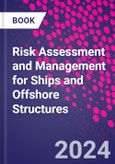The volatile, uncertain, complex, and ambiguous (VUCA) nature of environmental and operational conditions is still the major cause of marine accidents, with knock-on effects in terms of casualties, property damage, and marine pollution. Recognized as the most effective approach to navigate VUCA environments, risk-based assessment methods provide a solution to address challenges associated with health, safety, and environmental protection in extreme conditions and when accidents involving engineering structures and infrastructure occur. This book serves as a comprehensive guide to the foundational principles, current practices, and cuttingedge trends in quantitative risk assessment and management for ships and offshore structures. With six parts
encompassing a total of 35 chapters, it covers risk assessment and management for offshore installations, oil and gas leaks, collisions and grounding, and fires and explosions. Tailored for ship and offshore structural engineers, naval architects, as well as mechanical and civil engineers involved in advanced safety studies, this book is an invaluable resource for both practicing engineers and researchers in this field.
encompassing a total of 35 chapters, it covers risk assessment and management for offshore installations, oil and gas leaks, collisions and grounding, and fires and explosions. Tailored for ship and offshore structural engineers, naval architects, as well as mechanical and civil engineers involved in advanced safety studies, this book is an invaluable resource for both practicing engineers and researchers in this field.
Table of Contents
Part I Principles of Risk Assessment and Management1. Introduction to Risk Assessment and Management
2. Human Reliability Assessment
3. Risk-Based Inspection for Subsea Pipelines
Part II Risk Assessment and Management for Offshore Installations
4. Risk-Based Decision-Making
5. Risk Assessment Applied to Offshore Structures
6. Formal Safety Assessment Applied to Shipping Industry
7. Economic Risk Assessment for Field Development
8. Risk and Reliability Analyses of Floating, Production, Storage, and Offloading Units
9. Systematic Review of Floating Production Systems
10. Risk Assessment of Subsea Production System
11. Systematic Measures to Offshore Drilling Hazards
12. Deepwater Drilling: Problems and Solutions
13. Metocean Criteria for Internal Waves to Design Submarine Structures
14. Systems Numerical Modeling to Establish Metocean Criteria for Internal Solitary Waves
Part III Risk Assessment and Management for Oil and Gas Leaks from Manifolds
15. Fault Tree Analysis (FTA)
16. Analysis of the Principles of Valve Cavitation
17. Risk Assessment and Simulation of Oil/Gas Leakage
Part IV Risk Assessment and Management for Colliosions And Grounding Events
18. Determination of Collision Design Loads
19. Analysis of Structural Crashworthiness in Supply Vessel Collision Events
20. Structural Crashworthiness Analysis in Collision and Grounding
21. Collision Risk Assessment & Management
22. Grounding Risk Assessment & Management
23. Practical Finite Element (FE) Method to Simulate Structural Crashworthiness in Ship Collision and Grounding Events
Part V Risk Assessment and Management of Fires and Explosions
24. Leakage and Deflagration Accidents
25. Management of Risks Associated with Explosion Loads
26. Risk Management for Structural Failure Due to Explosions
27. Risk Management for Structural Failures Due to Fires
28. FEM-Based Analysis of the Progressive Collapse of Steel-Stiffened Plate Structures in Fire Events
29. Heat Radiation from Jet Fires
30. Risk Management for Fires
31. Risk Assessment and Management for Explosions
Part VI Risk Assessment and Asset Integrity Management
32. Asset Integrity Management for Offshore Installations
33. Probability and Risk-Based Inspection Planning
34. Risk and System Integrity Level Assessment for Offshore Facilities
35. Reliability-Centered Maintenance (RCM) for Offshore Installations








